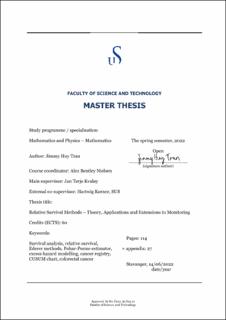| dc.description.abstract | In cancer research, one is often interested in the part of the hazard which corresponds to the disease. If the cause of death is unknown as in cancer registry data, the standard methods in survival analysis do not distinguish between the mortality due to disease and other causes. This issue becomes the main motivation for the development of relative survival methods. First, the main concepts in relative survival are presented. Both non-parametric estimators and models of the excess hazard are studied and discussed. Simulation studies show that even if the Pohar-Perme method is an unbiased estimator of the so-called net survival, the traditional Ederer 2 estimator might still be preferable in certain situations due to its lower variance. When informative censoring is present, the degree of bias looks to be the same on average for both estimators.
When it comes to modelling of the excess hazard, we cover two different types of models. The first group corresponds to parametric models where the baseline excess hazard is a piecewise constant function. For real-life data, this is usually not the case and a more flexible and semi-parametric model based on the EM-algorithm is therefore considered. By simulation, the piecewise constant models still perform decent if the gradient of the baseline excess hazard is not large and there are enough data such that a finer splitting of the follow-up interval can be used in the estimation procedure.
In some situations, one might also want to monitor the excess hazard over time in order to detect a change. An approach based on methods from relative survival and statistical process control is proposed for this intention. Different simulation setups are used in order to illustrate the purpose of the method. Finally, most of the methods presented are applied to colon and rectum cancer data from the Norwegian Cancer Registry. Interesting results are obtained from the analysis. For instance, the effect of tumour location seems to vary between age groups. Similar arguments are observed related to cancer stage as well. The CUSUM charts show a clear improvement in the excess hazard over time, which agree with the results from non-parametric methods when stratified by diagnosis year period. | |
